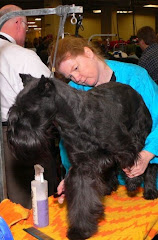Oral Hygiene for a Healthy Companion: Caring for Your Dog's Teeth
Teeth should be cleaned as often as possible, since this is not something your groomer will typically tend to.
Just like your own teeth, tartar and plaque build up on your dog’s teeth. Dogs are not prone to cavities but plaque buildup causes the gums to recede, in bad cases exposing the roots to tartar and plaque, loosening teeth and causing pain and odor. Badly neglected teeth and gums can introduce infection into the bloodstream which is an unnecessary burden on internal organs and can be a cause of heart disease
Clean the teeth with a canine toothpaste, applied with a gauze pad wrapped around your finger or a toothbrush. Plaque builds up the worst on the molars in the back of the mouth, so these should get extra attention.
By gradually increasing the time you spend and the degree of invasiveness over a lot of frequent sessions, your dog will accept having its mouth held open or closed while you work. While working, look at the gums and be sure they are uniform. Cancerous growths can start here so any overgrown or pendulous areas of gum should be examined by your vet.
Even if you regularly brush your dog’s teeth, you will sometimes need to have your dog’s teeth professionally scaled. If you can get a fingernail under the plaque and chip some off, it is high time for professional help. Some dog owners and groomers may know how to use a scaler to get the plaque off the teeth, but this should be limited to small amounts of plaque that are easily chipped off. Scraping the teeth with metal instruments will actually speed up the rate at which plaque forms because of tiny grooves left in the enamel. In most cases, your veterinarian should be the one to clean and scale teeth. Your dog will be sedated and after the plaque is removed the teeth will be polished and possibly even given a fluoride treatment.
Some dogs have gums that overgrow the teeth, rather than receding, and this leaves lots of pockets to harbor infection. Many vets can perform a gingevectomy (trimming of the overgrown gums) at the same time as a dental cleaning.
GAINING THE WINNER'S EDGE FOR YOUR SHOW DOG COMPANION
With close attention to details and some good coaching and assistance, you and your dog can both be winners, too. Here are suggestions that will help.
Subscribe to:
Post Comments (Atom)


.jpg)
Really i appreciate the effort you made to share the knowledge.The topic here i found was really effective to the topic which i was researching for a long time.Professional Pet Sitter
ReplyDeleteThanks a lot for blogging this, it was unbelieveably informative and helped me tons.Doggie Day Care Las Vegas
ReplyDelete